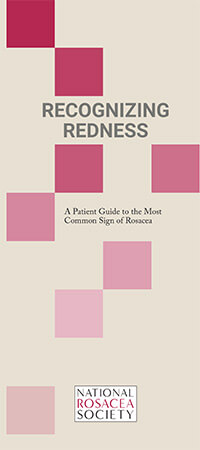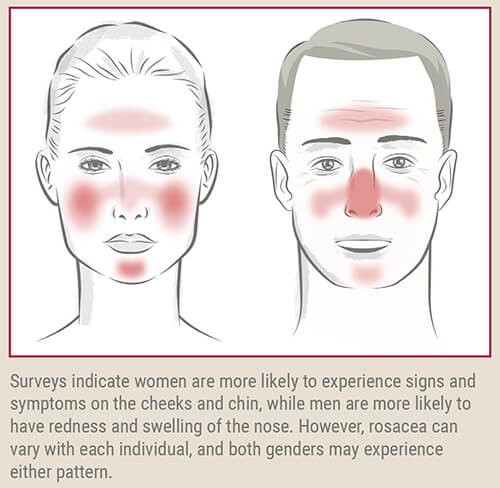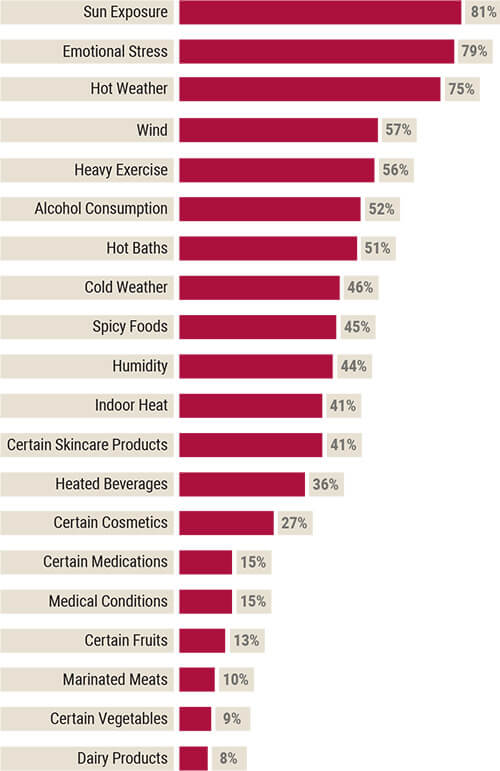Download a free PDF or read it online:
What Should I Look For?
 Facial redness is the primary diagnostic sign of rosacea, an embarrassing but treatable skin disorder estimated to affect more than 16 million Americans. In fact, persistent redness alone on the central part of the face – the nose, cheeks or chin – may be enough for a dermatologist to diagnose the condition. The Redness Register in this booklet is a tool that is designed to help determine if you should see a dermatologist for evaluation and appropriate care, and to monitor the progress of therapy.
Facial redness is the primary diagnostic sign of rosacea, an embarrassing but treatable skin disorder estimated to affect more than 16 million Americans. In fact, persistent redness alone on the central part of the face – the nose, cheeks or chin – may be enough for a dermatologist to diagnose the condition. The Redness Register in this booklet is a tool that is designed to help determine if you should see a dermatologist for evaluation and appropriate care, and to monitor the progress of therapy.
Rosacea often begins as flushing or facial redness that comes and goes. Without treatment, it may become ruddier and more persistent, often triggered by environmental or lifestyle factors that exacerbate the condition. Over time, bumps and pimples may also develop, and in severe cases the skin on the nose may thicken and appear swollen from excess tissue. In many patients, the eyes are also affected (ocular rosacea), with feelings of irritation, stinging or burning, and the eyes may appear bloodshot.
If you suspect you might have rosacea, see a dermatologist. Further information is available from the National Rosacea Society at rosacea.org. Medical therapies that are highly effective are now available to control the redness and other signs and symptoms of the disease before they become increasingly intrusive on your daily life.
How Is Rosacea Diagnosed?
Rosacea may be diagnosed in the presence of the following:
At least one diagnostic feature, including:
- persistent facial redness
- less commonly, thickening skin on the face (especially the nose)
Two or more major features, including:
- bumps and pimples
- flushing
- visible blood vessels
- eye irritation
Minor signs and symptoms that may occur along with the diagnostic or major features include:
- burning or stinging
- swelling
- dry appearance

Common Rosacea Triggers
In addition to medical therapy, rosacea patients can help control their condition by identifying and avoiding environmental and lifestyle factors that may trigger flare-ups in their individual cases. While the list of potential rosacea triggers may seem endless, a survey of 1,066 rosacea patients found that the most common included the following:

How to Use the Redness Register
 Determine the shade of redness that appears to represent the closest match for the redness in your skin, disregarding skin tone, and record the number. Next, look in the mirror and hold the redness register to your face where affected. Determine the shade that most closely matches the redness, and record the number.
Determine the shade of redness that appears to represent the closest match for the redness in your skin, disregarding skin tone, and record the number. Next, look in the mirror and hold the redness register to your face where affected. Determine the shade that most closely matches the redness, and record the number.
A difference of two or more shades may indicate rosacea, and the greater the difference the more severe your rosacea may be. Record the date each time you use the Redness Register in order to see if your redness changes; you may also use it to track improvement under medical therapy.
While there is no cure for rosacea, it may be managed with careful skin care and prescription medications. If you decide to seek treatment for rosacea, visiting a dermatologist may be a good first step. A dermatologist can make sure you are diagnosed appropriately and help you bring the condition under control. Bring your Redness Register results to your appointment, and be prepared to discuss any symptoms you may have noticed that may not be visible at the time of your visit.
Download a free PDF or join the National Rosacea Society to receive a printed copy of Recognizing Redness, as well as other educational information on rosacea and the newsletter Rosacea Review.
Support was provided by EPI Health.